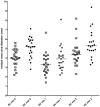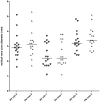Ultrasonographic assessment of the caudal vena cava diameter in cats during blood donation
- PMID: 34313488
- PMCID: PMC9160942
- DOI: 10.1177/1098612X211028838
Ultrasonographic assessment of the caudal vena cava diameter in cats during blood donation
Abstract
Objectives: Ultrasonography of the caudal vena cava (CVC) has been previously established to assess fluid status in dogs but not in cats. The aim of this study was to determine CVC diameter changes during feline blood donation.
Methods: Inter- and intra-observer variability were assessed in 11 client-owned cats. Minimal and maximal CVC diameters were assessed longitudinally in the subxiphoid view (SV) and right paralumbar view (PV), and transversely in the right hepatic intercostal view (HV). Eighteen client-owned, healthy, anaesthetised cats were evaluated during 21 blood donation procedures of 10 ml/kg in the same anatomical locations before (T0) and after (T1) blood donation, and after volume resuscitation with 30 ml/kg lactated Ringer's solution (T2). The CVC index was calculated.
Results: Intra-observer variability was acceptable for all probe positions, except for the HV, whereas inter-observer variability was considered unacceptable for all probe positions. Complete measurements were obtained during 21 blood donations at T0, T1 and T2 at the SV, during 18/21 blood donations at the HV and during 16/21 blood donations at the PV. At the SV, the minimal CVC diameter between T1 and T2 (P <0.001), and the maximal CVC diameter between T0 and T1 and between T1 and T2 (P <0.001) were significantly different. At the HV, the minimal vertical diameter, maximal vertical diameter and minimal horizontal diameter were different between all timepoints (P <0.001). The maximal horizontal diameter was different between T1 and T2 (P = 0.002). At the PV, both diameters were different between all timepoints (P <0.001). The CVC index was not different between timepoints.
Conclusion and relevance: Significant probe position dependent CVC diameter changes with marked overlap were observed before and after blood donation, and after fluid bolus. No absolute CVC diameter could be used to indicate hypovolaemia. Ultrasonographic assessment of the feline CVC is highly operator-dependent. The CVC index is not useful in cats.
Keywords: Point-of-care ultrasound; hypovolaemia; intravascular volume status; vena cava index.
Conflict of interest statement
The authors declare no potential conflicts of interest with respect to the research, authorship, and/or publication of this article.
Figures





Similar articles
-
Ultrasonographically derived caudal vena cava parameters acquired in a standing position and lateral recumbency in healthy, lightly sedated cats: a pilot study.J Feline Med Surg. 2022 Oct;24(10):1039-1045. doi: 10.1177/1098612X211064697. Epub 2021 Dec 14. J Feline Med Surg. 2022. PMID: 34904481 Free PMC article.
-
Establishment of reference values of the caudal vena cava by fast-ultrasonography through different views in healthy dogs.J Vet Intern Med. 2018 Jul;32(4):1308-1318. doi: 10.1111/jvim.15136. Epub 2018 May 10. J Vet Intern Med. 2018. PMID: 29749656 Free PMC article.
-
Feline caudal vena cava to aorta ratio reference interval.J Feline Med Surg. 2024 Dec;26(12):1098612X241303309. doi: 10.1177/1098612X241303309. J Feline Med Surg. 2024. PMID: 39703188 Free PMC article.
-
Point of care ultrasound measurement of paralumbar caudal vena cava diameter and caudal vena cava to aortic ratio in hypovolemic dogs.Front Vet Sci. 2024 Oct 28;11:1467043. doi: 10.3389/fvets.2024.1467043. eCollection 2024. Front Vet Sci. 2024. PMID: 39529853 Free PMC article.
-
Accuracy of Ultrasonographic Measurements of Inferior Vena Cava to Determine Fluid Responsiveness: A Systematic Review and Meta-Analysis.J Intensive Care Med. 2020 Apr;35(4):354-363. doi: 10.1177/0885066617752308. Epub 2018 Jan 17. J Intensive Care Med. 2020. PMID: 29343170
Cited by
-
Feline friendly POCUS: how to implement it into your daily practice.J Feline Med Surg. 2024 Sep;26(9):1098612X241276916. doi: 10.1177/1098612X241276916. J Feline Med Surg. 2024. PMID: 39254308 Free PMC article. Review.
-
Ultrasonographical Assessment of Caudal Vena Cava Size through Different Views in Healthy Calves: A Pilot Study.Vet Sci. 2022 Jun 22;9(7):308. doi: 10.3390/vetsci9070308. Vet Sci. 2022. PMID: 35878325 Free PMC article.
-
Ultrasonographically derived caudal vena cava parameters acquired in a standing position and lateral recumbency in healthy, lightly sedated cats: a pilot study.J Feline Med Surg. 2022 Oct;24(10):1039-1045. doi: 10.1177/1098612X211064697. Epub 2021 Dec 14. J Feline Med Surg. 2022. PMID: 34904481 Free PMC article.
-
The ultrasonographic evaluation of caudal vena cava diameter before and after fluid replacement in neonatal dehydrated calves with diarrhea.BMC Vet Res. 2025 Jul 2;21(1):424. doi: 10.1186/s12917-025-04759-z. BMC Vet Res. 2025. PMID: 40604891 Free PMC article.
References
-
- Davis H, Jensen T, Johnson A, et al.. 2013 AAHA/AAFP fluid therapy guidelines for dogs and cats. J Am Anim Hosp Assoc 2013; 49: 149–159. - PubMed
-
- Marik PE. Techniques for assessment of intravascular volume in critically ill patients. J Intensive Care Med 2009; 24: 329–337. - PubMed
-
- Wilson M, Davis DP, Coimbra R. Diagnosis and monitoring of hemorrhagic shock during the initial resuscitation of multiple trauma patients: a review. J Emerg Med 2003; 24: 413–422. - PubMed
-
- Celebi Yamanoglu NG, Yamanoglu A, Parlak I, et al.. The role of inferior vena cava diameter in volume status monitoring; the best sonographic measurement method? Am J Emerg Med 2015; 33: 433–438. - PubMed
-
- Marik PE, Baram M, Vahid B. Does central venous pressure predict fluid responsiveness? A systematic review of the literature and the tale of seven mares. Chest 2008; 134: 172–178. - PubMed
MeSH terms
LinkOut - more resources
Full Text Sources
Medical
Miscellaneous

